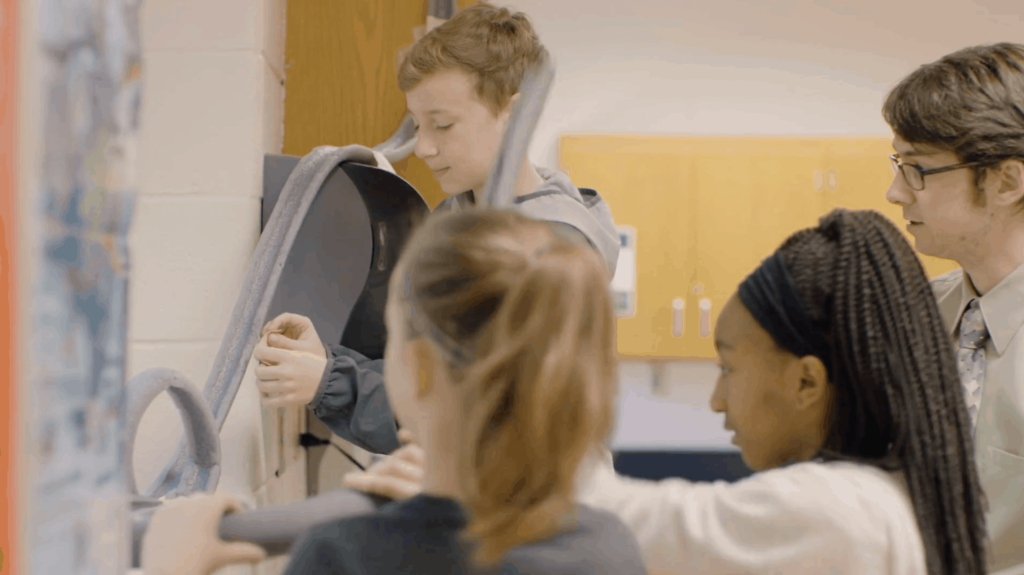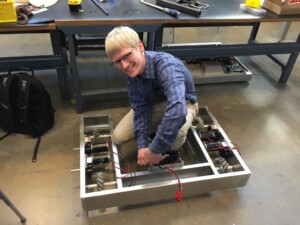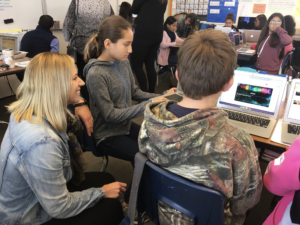Making Science Class into the Happiest Place on Earth with Projects

By: Zach Jernigan.
As a self-proclaimed science nerd, there are few things that can compare with my fascination for science. You might say that I enjoy exploring science as much as the average kid enjoys exploring Disneyland. So when I had the chance to present my sixth-grade students with a project that combined my love for science and their enthusiasm for amusement parks, I felt as if I had hit the jackpot.
Through Summit Learning, I discovered Forces at Work-Rollercoaster Design, a project that would teach my students all about gravity and friction. As I watched groups of students use imagination and science to build wild rollercoasters with foam and form their own personal “Tomorrowlands” and “Adventurelands,” I was amazed by the deep level of engagement.
I’m drawn to using projects to teach because it allows students to workshop their skills, think about what they’re learning in-depth and apply the content they’re learning in a meaningful way.
Long-term projects give students the chance to experiment with trial and error and design a process they can follow from beginning to end.
This project, my favorite in the curriculum, has taught me the key factors that make projects engaging for students. Here are a few tips I’ve learned.
Find a great project, but don’t be afraid to modify: I was fortunate to find an interesting project that aligned with the Next Generation Science Standards, K-12 science content standards backed by research, but I made certain adjustments to ensure that it reflected the grade-level curriculum and state standards. Some teachers spend time developing their own projects from the ground up, an admirable feat. However, between grading papers and tutoring students, time is not always an abundant resource for teachers. It’s useful to leverage resources to find a project idea and then finetune it to fit your classroom’s needs.
Begin a project with the end objective in mind: When beginning a journey with my students, I give them their destination first instead of a detailed road map. By informing them of the destination, or end objective, at the very start, there is a shared understanding across the classroom around what everyone will be learning. When the students understand where they are headed, it gives them more ownership over their learning. With the end objective in mind, they often get creative ideas and develop new routes to get there. It’s encouraging to see a spark of independence when students decide to help take the wheel — something essential for successful group projects (more on that later). When students feel a sense of ownership, they often feel more responsible and driven to succeed.
Emphasizing roles in group work: As educators, we can all look back on a time in our own academic journeys where we were saddled with the heavy lifting of a project while our teammates were able to coast by and sometimes even take the credit. Not in my classroom.
When many students enter a group project environment, they feel out of place and unsure of how they can add value to the team. In my class, students work together to identify and assign their unique roles and responsibilities. I have seen students take it upon themselves to create a contract that spells out the rules of the projects and each teammates’ duties. While some may think that this seems rigid, it truly empowers the students to understand how they can contribute and see value in their work.
Learning how to effectively work together on a team is a critical skill for success in college and career. In the modern workforce, employers are constantly seeking soft skills such as creativity and collaboration. When working in groups, students have the opportunity to learn how to collaborate and build knowledge with the help of peers.
Focus on cognitive skills: Forces at Work-Rollercoaster Design project is all about teaching students how gravity and friction influence the design of real-world structures. And while I hope my students will think about the law of gravity and engineering processes often, I know it’s much more realistic for students to rely upon the cognitive skills they learn on a daily basis.
Projects allow me to purposefully focus on teaching cognitive skills, which is great because it is these skills that are lifelong and that students will use forever. I’m confident that my students are ingraining on how to identify patterns and interpret data to design efficient processes. Takeaways like these remind me that what they learned in my class will be treasured skills that they can apply in other classes as well as future grade levels and careers.
Choosing fun projects makes class fun: It may sound obvious, but if the idea of a project bores you, then it’s likely to bore your students. Boredom is rarely used as an ingredient to create engagement.
When I first discovered the rollercoaster project, I was excited. I love rollercoasters, and I loved them when I was in my youth, too. As I recognized my own excitement, I knew that my students would feel the same way. When was the last time a project filled you with a genuine sense of enthusiasm and thrill?
Once we kicked off the project, I heard thoughtful conversations between group members among bouts of laughter. What’s more rewarding than seeing your students happy and learning? There were times when all students were on their feet thinking of unique ways to mold the model they had created. As the weeks went on, my students would tell me that they could not wait for the next class period so they can work on their rollercoaster. The fun and anticipation that they feel while working on the projects create a culture where it’s cool to care about your ideas, which encourages everyone to join in.
Utilizing engaging projects in the classroom is one of the best ways to encourage students to become driven, independent learners. Projects that capture the imagination, interest and attention of students allow them to exercise newly learned skills and apply fresh content. Enlisting projects that are truly fun effortlessly creates a class culture where students are participating and looking forward to class. In the midst of that excitement, students are walking away with skills that will be applicable for the rest of their academic careers.
For more, see:
- Taking the Guesswork Out of Science
- Workspace Education: A Creative Approach to Competency- and Project-Based Science
- Thinking With Your Hands
Zach Jernigan is a sixth-grade science teacher at Bailey Bridge Middle School in Midlothian, Virginia.
___________________________________________________________________________
Stay in-the-know with innovations in learning by signing up for the weekly Smart Update







0 Comments
Leave a Comment
Your email address will not be published. All fields are required.